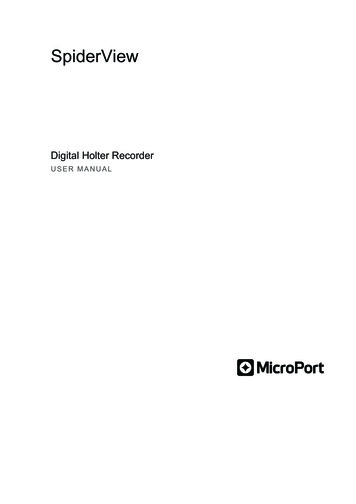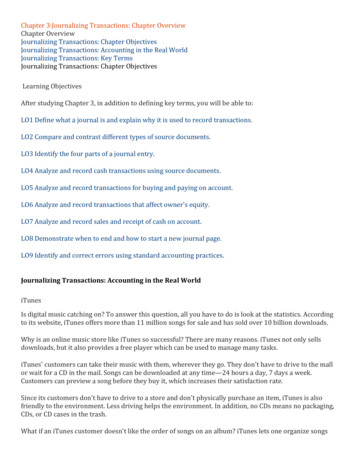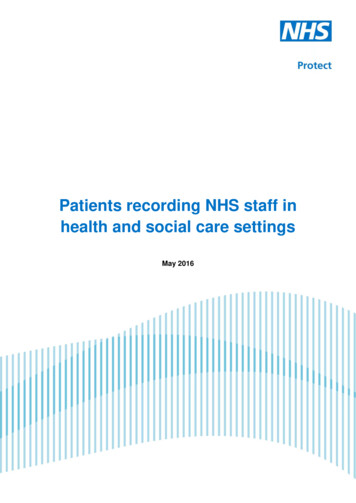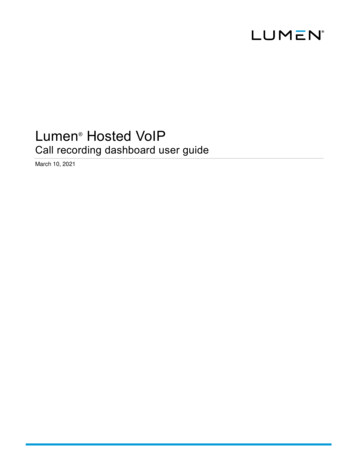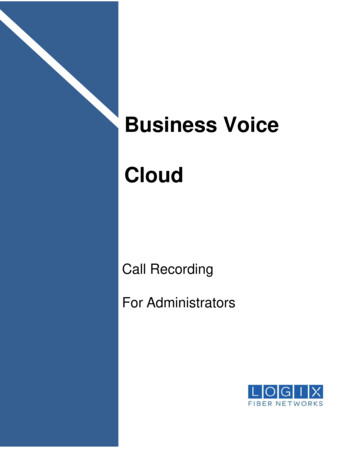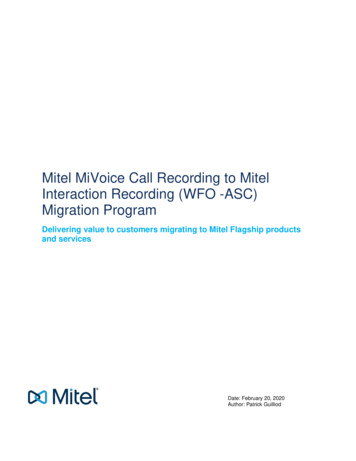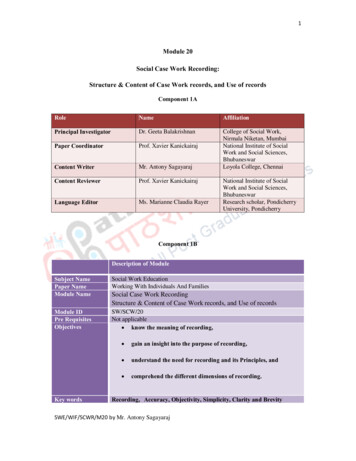
Transcription
2RECORDING BUSINESSTRANSACTIONSCON N ECTING C H APT ER 2LEARNING OBJECTIVE 1 Define and use key accounting termsWhat are the key terms used when recording transactions?The Accounting Cycle, page 60Chart of Accounts, page 61LEARNING OBJECTIVE 2 Apply the rules of debit and creditHow do we track changes in accounts?Double-Entry Accounting, page 63The T-Account Increases and Decreases in the AccountsExpanding the Rules of Debit and Credit: Revenues and ExpensesNormal Balance of an AccountLEARNING OBJECTIVE3 Analyze and record transactions in the journalHow do we record business transactions?Source Documents—The Origin of Transactions, page 67Recording Transactions in the Journal, page 67LEARNING OBJECTIVE4 Post from the journal to the ledgerWhat is the next step after recording the transaction?Posting (Transferring Information) from the Journal to the Ledger, page 69Accounting for Business Transactions, page 70The T-Accounts after PostingDetails of Journals and LedgersLEARNING OBJECTIVE5 Prepare and use a trial balanceHow can we check if the records are in balance?The Trial Balance, page 80Correcting Trial Balance ErrorsMyAccountingLabThe Summary for Chapter 2 appears on page 86. This lists all of the MyAccountingLab resources. AccountingVocabulary with definitions for this chapter’s material appears on page 87.58M02 HORN5371 10 SE C02.indd 586/25/15 5:39 PM
Acar dealership can be found in almost every town. Some are owned by local businesspeople while others are owned by larger corporations with owners in townsfar away. Guelph Toyota is a prime example of a small business that has grown tobe a large company. It started in 1983 and is now owned by Barry Dohms. He bought thebusiness in 2005 and also owns three other dealerships.Guelph Toyota uses financial information to make its business decisions. Its ownersand managers rely on the accounting system to provide them with daily and monthlyfinancial statements to run their business. Are the managers accountants? No! They aresmart businesspeople who know that they need to understand the daily and monthlyrevenues and expenses so that the business can survive in the short term and grow in thelong term. Guelph Toyota has been around for over 30 years, so it must be doing something right!The accounting department must provide timely information for decision makingby recording transactions as they occur. Most businesses prepare financial reports on amonthly basis. Managers in this dealership get daily financial reports. The managers readthem, see how their department is doing, and make changes immediately—reducingexpenses and identifying opportunities—based on the statements. The result? GuelphToyota is profitable. The company’s profits are used not only to expand the business,but also to support worthwhile community programs and events. Guelph Toyota andits partners, Kiwanis Club of Guelph and Co-operators Insurance, sponsor the GuelphPolice Department’s VIP Program, which teaches youth about a number of personalsafety issues.This chapter shows how Guelph Toyota and other companies record their businesstransactions. The procedures outlined in this chapter are followed by entities ranging fromgiant multinational corporations like Ford Canada, to regional businesses such as GuelphToyota, to local owner-managed businesses like Hunter Environmental Consulting.59M02 HORN5371 10 SE C02.indd 596/25/15 5:39 PM
Chapter 1introduced transaction analysis and the financialstatements by using a table based on the accounting equation to list all of thetransactions. This method of tracking account balances was useful to show howaccounts and statements connect, but there are too many transactions in a typicalbusiness to record information this way. In this chapter we will look at the waybookkeeping is done in the real world. First we look at the entire process and thenwe will go back and do it step by step.THE ACCOUNTING CYCLEThe accounting cycle is the formal process by which companies produce theirfinancial statements and update their financial records for a specific period oftime. Exhibit 2–1 outlines the complete accounting cycle. In this chapter, we willlook at steps 1 through 4, which represent what is done during the accountingperiod. The next two chapters will introduce the last steps in the cycle, whichare done at the end of the period.LO 1What are the key termsused when recordingtransactions?EXHIBIT 2–1 The Accounting CycleStart with thebalances in theledger at thebeginning ofthe period9Prepare the postclosing trtrial balance1Identify and analyzetransactions as theyoccur82Journalizealize anand postthe closinglosing entriesRecord transactionsin a journal73Post (copy) fromthe journal to theledger accountsOPTIONAL:WorksheetPrepareepare thetfinancialal statemstatements6Preparerepare an adjustedadjtrialrial balance54Prepare theunadjusted trialbalanceJournalize and postadjustingjg entries60Part 1 The Basic Structure of AccountingM02 HORN5371 10 SE C02.indd 606/25/15 5:39 PM
Recall that the basic summary device of accounting is the account, which isthe detailed record of the changes that have occurred in a particular asset,liability, or item of owner’s equity during a period of time. Business transactionscause these changes.For a new business, the cycle begins with setting up (opening) the ledgeraccounts. Lisa Hunter started Hunter Environmental Consulting (HEC) onApril 2, 2016, so the first step in the cycle was to plan and open the accounts.Account balances carry over from period to period until the accountingcycle is complete, for example, at the end of one year. Therefore, the accountingcycle usually starts with the account balances at the beginning of the period.START123Our first step is to analyze the transaction to identify changes in accounts.Accountants record transactions first in a journal, which is the chronologicalrecord of transactions.Accountants then copy (post) the data to a record of all the accounts called theledger. (One way to think of a ledger is as a binder, with each page in the binder representing one account.) In the phrase “keeping the books,” books refers tothe ledger. Exhibit 2–2 shows how asset, liability, and owner’s equity accountscan be grouped into the ledger.EXHIBIT 2–2 The Ledger (Asset, Liability, and Owner’s Equity Accounts)Cash4Individual asset accountsAccountsPayableIndividual liability accountsHunter,CapitalIndividual owner’s equity accountsAll the accountscombined makeup the ledger.rLedgeThen a list of all the ledger accounts and their balances is prepared. This is calleda trial balance, or more precisely, an unadjusted trial balance at this stage.CHART OF ACCOUNTSCompanies use a chart of accounts to list all their accounts. This is just a list andnot a financial statement. In many cases, the account names are listed along withthe account numbers. Account numbers are just shorthand versions of the accountnames. One number equals one account name—just like your social insurancenumber is unique to you. This numbering system makes it easy to locate individual accounts in the ledger and to key in entries in an accounting software program.Accounts are identified by account numbers with two or more digits. Assetsare often numbered beginning with 1, liabilities with 2, owner’s equity with 3,revenues with 4, and expenses with 5. The second, third, and higher digits in anaccount number indicate the position of the individual account within the category.The chart of accounts for Hunter Environmental Consulting appears in Exhibit 2–3.Notice the gap in account numbers between 1200 and 1400. Lisa Hunter realizes that at some later date the business may need to add another category ofLEARNING TIPSIt would be helpful to make yourown list of accounts as you learnnew account names.Chapter 2 Recording Business TransactionsM02 HORN5371 10 SE C02.indd 61616/25/15 5:39 PM
EXHIBIT 2–3 Chart of Accounts—Hunter Environmental ConsultingBalance Sheet AccountsREAL WORLDEXAMPLEAssetsCompanies do not need to use thenumbering system illustrated here.They can develop any system thatmakes sense to them. For example,a Ford dealership uses account7630 for Parts DepartmentAdvertising Expense and a GeneralMotors dealership uses accountnumber 065-07 for the exact sameexpense.LiabilitiesOwner’s Equity1100 Cash2100 Accounts Payable3000 Lisa Hunter, Capital1200 Accounts Receivable2300 Notes Payable3100 Lisa Hunter,Withdrawals1400 Office Supplies1500 Furniture1900 LandIncome Statement Accounts(part of Owner’s Equity)RevenuesExpenses4000 Service Revenue5100 Rent Expense5200 Salaries Expense5300 Utilities Expensereceivables—for example, Notes Receivable—to be numbered 1210. This companychose to use a four-digit numbering system. However, each company chooses itsown account numbering system.The expense accounts are listed in alphabetical order throughout this chapter.Many businesses follow such a scheme for their records and financial statements.Computer programs list accounts alphabetically or by account number. Othersystems of ordering are by size or by type (e.g., listing selling costs then listingadministrative costs). Try It!1. Indicate whether each account listed below is a(n) asset (A), liability (L), owner’s equity (OE), revenue (R), or expense (E) account.Salary PayableLandL. Graham, CapitalRent ExpenseSuppliesAccounts PayableSalary ExpenseRent RevenueComputer EquipmentNotes PayablePrepaid RentL. Graham, Withdrawals2. Create a chart of accounts by matching each of the following account names with an appropriateaccount number. Assume this company uses a system similar to that described in the chapter, withasset numbers beginning with 1 and expense numbers beginning with 5.Accounts PayableRent ExpenseFurniture and FixturesService RevenueL. Starks, CapitalAccounts ReceivableCashIncome Taxes PayableL. Starks, 010200Solutions appear at the end of this chapter and on MyAccountingLab62Part 1 The Basic Structure of AccountingM02 HORN5371 10 SE C02.indd 626/25/15 5:39 PM
DOUBLE-ENTRY ACCOUNTINGLO 2Accounting uses the double-entry system, which means that we record the dual,or two, effects of each transaction. As a result, every transaction affects at least twoaccounts.Consider a cash purchase of supplies. What are the dual effects of this transaction? A cash purchase of supplies:1. Increases supplies (the business received supplies)2. Decreases cash (the business gave cash)Similarly, a credit purchase of a truck (a purchase made with a bank loan):1. Increases vehicles (the business received the truck)2. Increases the bank loan payable (the business gave a promise to pay in thefuture)How do we track changesin accounts?One way to think about this isto remember the old adage “you don’t get somethingfor nothing.” In accounting,money does not just appearand goods are not receivedwithout payment. There arealways at least two sides toeach transaction.The T-AccountThe form of account used for most illustrations in this book is called theT-account because it takes the form of the capital letter “T.”The vertical line divides the account into its left and right sides, with theaccount title at the top. For example, the Cash account appears in the followingT-account format:Cash(Left side)Debit(Right side)KEY POINTSA T-account is a quick way toshow the effect of transactionson a particular account—a usefulshortcut or tool used in accounting. T-accounts are not part of theformal accounting records.CreditThe left side of the account is called the debit side, and the right side is calledthe credit side.Even though left side and right side may be more convenient, debit and credit arewhat they are called in a business environment.1 Debit and credit are abbreviatedas follows:Dr 5 DebitCr 5 CreditIncreases and Decreases in the AccountsThe type of an account (asset, liability, owner’s equity) determines how we recordincreases and decreases. For any given type of account, all increases are recordedon one side, and all decreases are recorded on the other side. Increases in assets arerecorded in the left (debit) side of the account. Decreases in assets are recordedin the right (credit) side of the account. Conversely, increases in liabilities andowner’s equity are recorded by credits. Decreases in liabilities and owner’s equity1Debits are not “good” or“bad.” Neither are credits. Debits are not alwaysincreases and credits arenot always decreases. Debitsimply means left side, andcredit means right side.The words debit and credit abbreviate the Latin terms debitum and creditum. Luca Pacioli, the Italianmonk who wrote about accounting in the 15th century, used these terms.Chapter 2 Recording Business TransactionsM02 HORN5371 10 SE C02.indd 63636/25/15 5:39 PM
are recorded by debits. These are the rules of debit and credit and can be summarizedas follows:AssetsLiabilities and Owner’s EquityIncrease 5 Debit Decrease 5 CreditDecrease 5 Debit Increase 5 CreditThis pattern of recording debits and credits is based on the accounting equation:ASSETS 5 LIABILITIES 1 OWNER’S EQUITYDEBITS 5 CREDITSAssets are on the opposite side of the accounting equation from liabilities andowner’s equity. Therefore, increases and decreases in assets are recorded in theopposite manner from increases and decreases in liabilities and owner’s equity.Liabilities and owner’s equity are on the same side of the equal sign, so they aretreated in the same way. Exhibit 2–4 shows the relationship between the accounting equation and the rules of debit and credit.EXHIBIT 2–4 The Accounting Equation and the Rules of Debit and Credit(The Effects of Debits and Credits on Assets, Liabilities, andOwner’s Equity)AccountingEquation:Rule ofDebit andCredit:REAL WORLDEXAMPLEIn a computerized accountingsystem, the software interpretsdebits and credits as increases ordecreases based on the accounttype that is programmed intoit. For example, software readsa debit to Cash as an increasebecause it is an asset account,and it reads a debit to AccountsPayable as a decrease because it isa liability IESDebit2Credit11OWNER’S EQUITYDebit2Credit1To demonstrate the rules shown in Exhibit 2–4, reconsider Transactions 1 and2 from Chapter 1 on pages 15–16. In Transaction 1, Lisa Hunter invested 250,000cash to begin her environmental consulting firm. The company received 250,000cash from Hunter and gave her the owner’s equity. We are accounting for the business entity, Hunter Environmental Consulting (HEC). What accounts of HEC areaffected? By what amounts? On what side (debit or credit)? The answer is thatassets and owner’s equity would increase by 250,000, as the following T-accountsshow:ASSETSCashDebit forincrease,250,0005 LIABILITIES 1 OWNER’S EQUITYLisa Hunter, CapitalCredit forincrease,250,000KEY POINTSIn each transaction, total debitsmust equal total credits.64The amount remaining in an account is called its balance. Transaction 1gives Cash a 250,000 debit balance and Lisa Hunter, Capital a 250,000 creditbalance.Part 1 The Basic Structure of AccountingM02 HORN5371 10 SE C02.indd 646/25/15 5:39 PM
Transaction 2 is a 100,000 cash purchase of land. This transaction affects twoassets: Cash and Land. It decreases (credits) Cash and increases (debits) Land, asshown in the T-accounts:ASSETSBalance250,000 Credit fordecrease,Video: Rules of Debits and Credits5 LIABILITIES 1 OWNER’S EQUITYCashBalanceMyAccountingLabLisa Hunter, CapitalBalance250,000100,000150,000LandDebit forincrease,100,000Balance100,000After this transaction, Cash has a 150,000 debit balance ( 250,000 debit balancefrom the previous transaction reduced by the 100,000 credit amount), Land has adebit balance of 100,000, and Lisa Hunter, Capital has a 250,000 credit balance,as shown in the section of Exhibit 2–5 labelled Transaction 2. Notice that the debitsstill equal the credits, but there are now two accounts on the left side.EXHIBIT 2–5 Debits and Credits for the First Two Transactions ofHunter Environmental ConsultingTransaction 1Transaction 2Received 250,000 cash that theowner invested in the businessPaid 100,000 cash topurchase landDEBITSCREDITSCash 250,000Lisa Hunter,Capital 250,000DEBITSCash 150,000CREDITSLisa Hunter,Capital 250,000Land 100,000We create accounts as they are needed. The process of creating a new accountin preparation for recording a transaction is called opening the account. ForTransaction 1, we opened the Cash account and the Lisa Hunter, Capital account.For Transaction 2, we opened the Land account.Expanding the Rules of Debit and Credit:Revenues and ExpensesOwner’s equity includes revenues and expenses because revenues and expensesmake up net income or net loss, which flows into owner’s equity. As we discussedin Chapter 1, revenues are increases in owner’s equity from providing goods andChapter 2 Recording Business TransactionsM02 HORN5371 10 SE C02.indd 65656/25/15 5:40 PM
services to customers. Expenses are decreases in owner’s equity from using assetsor increasing liabilities in the course of operating the business. Therefore, we mustexpand the accounting equation as we did in Exhibit 1–10 (page 15). Exhibit 2–6shows revenues and expenses under equity because they directly affect owner’sequity.EXHIBIT 2–6 Expanded Accounting EquationAssetsDr1Liabilities5Cr2Dr21Owner’s EquityCr1Owner’s Net Income(or – Net Loss)1Cr2RevenuesDr22Cr1ExpensesDr1Cr2Normal Balance of an AccountAn account’s normal balance appears on the side of the account—debit or credit—where increases are recorded. For example, Cash and other assets usually have adebit balance, so the normal balance of assets is on the debit side. Conversely, liabilities and owner’s equity usually have a credit balance, so their normal balancesare on the credit side. Exhibit 2–7 illustrates the normal balances by highlightingthe side where the balance is increased.One way to memorizethis is to use an acronym,such as AWE ROL. In thiscase, the (A)sset, (W)ithdrawal,and (E)xpense accounts allhave debit balances, whilethe (R)evenue, (O)wner’s Equity,and (L)iability accounts all havecredit balances.Or memorize which side hasthe “ ” (increase), and thenall the “-” (decreases) are theopposite. This way you only haveto memorize half of them!Try DR. AWE—the debits (dr)belong with the (A)sset,(W)ithdrawal, and(E)xpense accounts.66EXHIBIT 2–7 Final Rules of Debit and CreditAssets5 Liabilities 1Assets5Dr1Cr2LiabilitiesDr1Cr21Owner’s EquityOwner,CapitalDr1Cr2Owner,2 Withdrawals 1Dr1Cr2RevenuesDr1Cr22ExpensesDr1Cr2An account that normally has a debit balance may occasionally have a creditbalance, which indicates a negative amount of the item. For example, Cash willhave a credit balance if the entity overdraws its bank account. Similarly, theliability Accounts Payable—normally a credit balance account—will have a debitbalance if the entity overpays its accounts payable. In other instances, the shift ofa balance amount away from its normal column may indicate an accounting error.For example, a credit balance in Office Supplies, Furniture, or Buildings is an errorbecause negative amounts of these assets cannot exist.Part 1 The Basic Structure of AccountingM02 HORN5371 10 SE C02.indd 666/25/15 5:40 PM
Try It!3. Indicate whether each account listed below is a(n) asset (A), liability (L), owner’s equity (OE), revenue (R), or expense (E) account. Next to each answer, indicate whether the account’s normal balanceis a debit (Dr) or a credit (Cr).Accounts Payable;Cash;Service Revenue;Rent Expense;K. Lockyer, Withdrawals;Vehicles;Rent Revenue;Notes Payable;Accounts Receivable;Land;Insurance Expense;K. Lockyer, Capital ;4. a. Indicate on which side of these accounts—debit (Dr) or credit (Cr)—you would record anincrease.Accounts ReceivableSalary ExpenseJohn Ladner, CapitalInterest PayableService RevenueFurnitureb. Indicate on which side of these accounts—debit (Dr) or credit (Cr)—you would record a decrease.Notes PayableLandCashAccounts PayableIncome Tax PayableIncome Tax ExpenseSolutions appear at the end of this chapter and on MyAccountingLabSOURCE DOCUMENTS—THE ORIGIN OFTRANSACTIONSAccounting data come from source documents, which are the evidence of a transaction. For example, when Hunter Environmental Consulting (HEC) receives cashor a cheque, it deposits the money into its bank account. The bank deposit slipis the document that shows the amount of money received by the business anddeposited in its bank account. Based on this document, the company can recordthis transaction in the accounting records.Other source documents that businesses use include:LO 3How do we recordbusiness transactions? Purchase invoice: A document that tells the business how much to pay andwhen to pay the vendor. Bank cheque: A document that tells the amount and the date of cash payments. Sales invoice: A document sent to the customer when a business sells goods orservices and tells the business how much revenue to record.RECORDING TRANSACTIONS IN THE JOURNALWe could record all transactions directly in the ledger accounts, as we have shownfor the first two HEC transactions. However, that way of accounting does notleave a clear record of each transaction. You may have to search through all theaccounts to find both sides of a particular transaction. To stay organized and keepall information about a transaction in one place, accountants first keep a record ofeach transaction in a journal, the chronological (listed by date) record of the entity’stransactions. They then transfer this information from the journal into the accounts.Chapter 2 Recording Business TransactionsM02 HORN5371 10 SE C02.indd 67676/25/15 5:40 PM
The process for thinking through how to write a journal entry is as follows:Transaction:Identify the transactions from source documents.Analysis:Identify each account affected by the transaction and its type(asset, liability, owner’s equity, revenue, or expense). Determinewhether each account is increased or decreased by the transaction. Using the rules of debit and credit, determine whether todebit or credit the account to record its increase or decrease.AccountingEquation:Verify that the increases and decreases result in an accountingequation that is still in balance.Journal Entry: Record the transaction in the journal, as explained inExhibit 2–8. Total debits must always equal total credits. Thisstep is also called “making the journal entry” or “journalizingthe transaction.”EXHIBIT 2–8 The JournalDate of the transactionDebit account name and dollar amount.Debits are always listed first.JournalDatePage 1Account Titles and ExplanationDebitCash250,000Credit2016Apr. 2Lisa Hunter, Capital250,000Received initial investment from owner.Brief explanationMyAccountingLabVideo: Journalizing TransactionsCredit account name anddollar amount. The creditaccount name is indented.Dollar signs are omitted in themoney columns because it isunderstood that the amountsare in dollars.Regardless of the accounting system in use—computerized or manual—anaccountant must analyze every business transaction in the manner we are presenting in these opening chapters. Accounting software performs the same actions asaccountants do in a manual system. For example, when a sales clerk swipes yourVISA card through the credit-card reader, the accounting system records both thestore’s sales revenue and the receivable from VISA. The software automaticallyrecords the transaction as a journal entry, but an accountant had to program thecomputer to do so. A computer’s ability to perform routine tasks and mathematical operations quickly and without error frees accountants for decision making. Try It!5. For each of the following transactions, select the source document that provides the best evidenceof the transaction. Choose from these source documents: bank deposit slip, bank cheque, invoicereceived from a vendor, or invoice sent to a customer.a. A company purchases supplies on account.b. A company pays for the supplies it purchased in Transaction a.68Part 1 The Basic Structure of AccountingM02 HORN5371 10 SE C02.indd 686/25/15 5:40 PM
c. A company performs services on account for a college.d. The college pays the company for the services performed in Transaction c.e. A customer pays the company immediately for services performed.f. The company hires a student to provide office support during the summer.6. Analyze the following transactions of Peterson Engineering in the manner shown for the September 1transaction.Sep.148122427Paid monthly utilities expense of 140.(Analysis: The expense for utilities is increased; therefore, debit Utilities Expense.The asset, cash, is decreased; therefore, credit Cash.)Borrowed 10,000 cash, signing a note payable.Performed service on account for a customer, 3,000.Purchased equipment on account, 2,000.Purchased supplies for 600 and paid cash.Paid the liability created on September 12.Solutions appear at the end of this chapter and on MyAccountingLabPOSTING (TRANSFERRING INFORMATION) FROMTHE JOURNAL TO THE LEDGERJournalizing a transaction records the data only in the journal—but not in theledger. Remember, the ledger tracks all transactions related to an account. Toappear in the ledger, the data must be copied or transferred there. The process oftransferring data from the journal to the ledger is called posting.Posting really just means copying a debit in the journal to a debit in the ledgerand a credit in the journal to a credit in the ledger. The first transaction of HunterEnvironmental Consulting is posted to the ledger as shown in Exhibit 2–9. Herewe are using a T-account as a short form for a ledger. In Exhibit 2–11 we illustrateposting the same transaction in a three-column ledger, which is used in formalaccounting records.LO 4What is the next stepafter recording thetransaction?EXHIBIT 2–9 Making a Journal Entry and Posting to the LedgerPanel A – Journal EntryJournalDateAccount Titles and ExplanationPage 1Post.Ref.DebitCredit2016Apr. 2Cash250,000Lisa Hunter, Capital250,000Received initial investment from owner.Panel B – Posting to the LedgerCash(1)250,000Lisa Hunter, Capital(1)250,000Chapter 2 Recording Business TransactionsM02 HORN5371 10 SE C02.indd 69696/25/15 5:40 PM
ACCOUNTING FOR BUSINESS TRANSACTIONSSo, to recap, steps1–3of the accounting cycle are as follows:Identify and analyze transactions as they occur.Record transactions in a journal.Post (copy) from the journal to the ledger accounts.123In the pages that follow, we record the transactions of Hunter EnvironmentalConsulting (HEC) from Chapter 1. Keep in mind that we are accounting for thebusiness entity and not recording Lisa Hunter’s personal transactions.We temporarily ignore the date of each transaction in order to focus on theaccounts and their dollar amounts. We will also post the transactions to T-accountsinstead of ledger accounts for the same reason.1. Transaction: Lisa Hunter invested 250,000 cash to begin her environmental consulting business, Hunter Environmental Consulting.The money was deposited in the company’s bank account, asshown by the following deposit slip:CREDIT ACCOUNT OF:HUNTER ENVIRONMENTAL CONSULTING10300 004 06000303600BUSINESS ACCOUNT DEPOSIT SLIPBANK OF THE PEOPLESHOPPING CONCOURSE BRANCHVANCOUVER, BC Y2R 2X1DATEDAY02MONTH04YEAR16CREDIT ACCOUNT OF:HUNTER ENVIRONMENTAL CONSULTING10300 004 06000303600LIST OF CHEQUESCHEQUE IDENTIFICATIONDATEDAY021 Lisa ASH COUNT5102050100 2 COIN 1 COIN34567COINCASHSUBTOTAL89DEPOSIT10ENTER CREDIT CARDVOUCHER LDEPOSITTOTAL Analysis:70 Hunter’s investment in Hunter Environmental Consultingincreased its asset cash; to record this increase, debit Cash. Theinvestment also increased its owner’s equity; to record thisincrease, credit Lisa Hunter, Capital.Part 1 The Basic Structure of AccountingM02 HORN5371 10 SE C02.indd 706/25/15 5:40 PM
AccountingASSETSEquation:5LIABILITIESOWNER’S EQUITY1CashLisa Hunter, Capital 250,00005LEARNING TIPS250,0001Don’t forget!The journal entry records the same information that you learned by using theaccounting equation in Chapter 1. Both accounts—Cash and Lisa Hunter, Capital—increased because the business received 250,000 cash and gave Hunter 250,000 of capital (owner’s equity) in the business.AssetsDr1Cr2LiabilitiesCash . 250,000Lisa Hunter, Capital .Received initial investment from 2Owner, CapitalLisa Hunter, Capital250,000(1)250,000Dr22. Transaction: Hunter Environmental Consulting paid 100,000 cash for landas a future office location.AccountingEquation:The purchase decreased cash; therefore, credit Cash. The purchase increased the entity’s asset, land; to record this increase,debit Land.ASSETS5CashLand2100,000 1100,000 5LIABILITIES1OWNER’S EQUITY010Cr1Owner, sDr1Cr2This transaction increased one asset, land, and decreased another asset, cash.The net effect on the business’s total assets was zero, and there was no effect onliabilities or owner’s equity. We use the term net in business to mean an amountafter a subtraction.JournalEntry:LedgerAccounts:Land . 100,000Cash .Paid cash for land.Cash(1)250,000100,000Land(2) 100,000(2) 100,0003. Transaction: The business purchased office supplies for 7,000 onaccount, as shown by the purchase invoice on the next page.Analysis:The purchase of office supplies increased this asset, so we debitOffice Supplies. The purchase was on account, so it also increaseda liability; to record this increase, credit Accounts 00055LIABILIT
Chapter 2 Recording Business Transactions 61 START Recall that the basic summary device of accounting is the account, which is the detailed record of the changes that have occurred in a particular asset, liability, or item of owner's equity during a period of time. Business transactions cause these changes.


